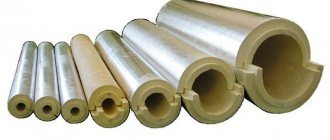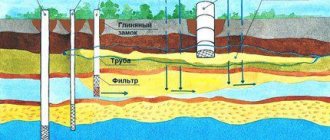Are you familiar with the situation when the water supply from the tap stops when the temperature outside is below freezing? This problem occurs in your home with the onset of cold weather, but you don’t know how to quickly fix it? To combat this, it is necessary to select an effective method for restoring the functionality of the water supply network. Do you agree?
We will tell you how to thaw a frozen pipeline and how to prevent a problem situation from occurring in the future. We will tell you about effective ways to quickly restore the water supply on a cold winter day for sanitary and hygienic purposes and cooking.
Our article provides a selection of the best ways to help you cope with this problem on your own. Methods for pipelines made of various materials are considered. So that you can better understand the nuances of warming up, we have selected visual photos and thematic videos detailing recommendations for rescuing a water supply system from ice captivity.
Causes of pipeline freezing
Before we figure out what to do if the water in the water pipes freezes, let's figure out why this might happen. Main reasons:
- laying pipes at insufficient depth;
- a small layer of insulation, its low quality or complete absence;
- insignificant or zero water consumption in severe frosts;
- abnormal weather conditions.
As a rule, pipes running outside freeze, either outside or underground. But in the absence of heating and significant subzero temperatures for a long time, a problem may arise in the room or at the point where the pipe enters the wall.
Using steam generators
Defrosting pipes using a steam generator is suitable if it is possible to gain access to the inside of the structure, and in some situations the pipeline will have to be disconnected. Steam is supplied from the device through a hose, at the end of which there is a nozzle installed, which can significantly increase the efficiency of work. The hose moves through the pipe as the ice melts.
The use of a powerful steam generator is optimal when it is necessary to quickly eliminate an emergency situation associated with the formation of ice in a pipeline.
In addition to such equipment, you can use a device for hydrodynamic cleaning with hot water. The productivity of this installation is slightly less than that of a steam generator, but this does not make it less effective.
One of the benefits of de-icing pipes from the inside is that at the same time as the ice is removed, the system is cleared of unwanted deposits. This allows you to bring the pipe cross-section to a normal value and improve fluid circulation in the structure.
A steam generator for defrosting pipes also has an obvious drawback - its dimensions and cost. If electrical equipment can be purchased at any store and used for household needs, then a steam generator is a different case. This type of technology is used mostly by professional companies.
Finding a traffic jam
Before deciding how to thaw a frozen water supply, you should first find where the ice blockage has formed in the pipe. Most often they form at the joints of elements, but sometimes the structure freezes along its entire length. Search methods:
- Visual inspection of external pipes. Due to the fact that water expands in volume when it freezes, ice plugs cause the plastic elements to expand. In addition, these areas feel cooler to the touch than others.
- Internal check. If it is not possible to inspect the pipeline, you should partially disassemble it and insert a flexible cable into the hole. As soon as an obstacle arises in the way of its progress, a traffic jam is detected. To determine its location, you should measure the length of the inserted cable.
The solution to the problem of how to warm up a frozen water pipe depends on whether there is open access to the problem area, or whether it needs to be warmed up from inside the water supply system.
Heating with an open fire
This method is used only for frozen steel pipes. When working, you need to use a blowtorch or a gas burner; if these tools are not available, you can use a regular fire. Important tip: you need to put a sheet of metal under the pipe so that the heat is reflected better. The frozen part of the pipeline is heated by an open fire, and the resulting water gradually spreads throughout the system. This method is used only when pipes are visible.
External heating of the pipe
If the water in the pipe is frozen, how can you warm it up from the outside? If there is open access to the area where the ice jam has formed, it is not difficult to solve the problem. Before heating, be sure to open the taps so that the melted liquid can come out freely. The main methods involve the use of:
- hot water;
- warm air;
- elements of the “warm floor” system (heating cable).
Hot water
This method is suitable for any pipes: polypropylene, metal-plastic, metal, and others. But the water temperature should be increased gradually so that the structure does not crack.
Warm up the frozen open section of the pipe with hot water
Stages:
- Wrap the cloth around the frozen area. This is necessary to protect the pipe and distribute heat more evenly.
- Place a container under the pipe to collect water.
- Run hot water over the area for several minutes.
- Periodically wring out the fabric and repeat until the water supply is restored.
Warm air
It is best to use a hair dryer as a source of warm air. It should be aimed at the area with the ice plug and held for a while.
If the freezing area is small and the pipe is thin, then you can use a regular hair dryer, but it should not work for more than 15 minutes at a time. It is advisable to wrap the pipe with heat-insulating material and blow hot air under it. This “casing” will speed up warming up.
Construction hair dryer
It is useless to use a fan heater or electric radiator, since they cannot create a concentrated air flow. You can safely defrost metal pipes with a construction hairdryer. It can damage plastic structures if used carelessly.
Heating cable
To heat a plastic pipe, you will need an electric cable, which is used when installing a “warm floor” or a special cable for heating pipes. Algorithm of actions:
- Wrap a section of pipe with foil. Place the electrical cable on top.
- After the cable, put a layer of insulation. Secure everything with tape.
- Connect the cable to the network for 2-4 hours.
Heating a water supply with a heating cable
Note: Metal structures can be heated using a welding machine by attaching it to a frozen section of the pipe. It is also allowed to use open sources of fire - a fire, a blowtorch. Such methods are not suitable for propylene and other plastic pipes.
Overview of different methods
The water supply can be defrosted using various methods of applying external heat to the pipe, or by defrosting it from the inside.
Method 1. Use hot water
If there is a suspicion that the water supply is frozen in an open area - at the entrance to the house, in an unheated basement, etc., boiling water is used to warm it up.
To do this, you must first wrap the pipe with any rag that will absorb water and prolong the time the pipe is in contact with boiling water. Pour hot water until the ice begins to melt. And to speed up the process, the tap must be left open.
The easiest way to warm a frozen pipe is to pour boiling water on it.
This method is used only indoors, because if the pipe is underground, it will take a long time to warm it with boiling water - at least 12 hours.
Method 2. Use a hair dryer
The pipe can be defrosted using hot air produced by a powerful hair dryer. The surface of the pipe is blown from all sides, and to reduce heat losses it is recommended to erect a small pavilion made of plastic film, for example, over the frozen pipe. If the pipe is plastic, you need to correctly calculate the heating so as not to melt it.
Solving the problem of defrosting a water pipe using a conventional hair dryer, but you can also use a construction tool
If the pipes freeze slightly, you can use a household hair dryer or fan heater to warm it up. If there are turns, narrowings, or entrances to fittings, they also need to be warmed up, as ice pieces can get stuck there. And in this case, do not forget to leave the tap open.
Method 3. Electric current comes to the rescue
How to warm a frozen water pipe using electric current?
Heating of a metal water supply can be done using a welding transformer: the positive wire is connected to one end of the pipe, and the negative wire to the second. In this simple way, the problem can be solved in a few minutes: the ice plug will melt.
The time for heating frozen metal water pipes with a welding transformer is minimal
Heating of a plastic pipeline can be done using a two-core copper wire with a cross-section of 2.5 mm. This method is similar to the operating principle of a conventional home boiler. The wire strands are disconnected. One of them is simply bent, and the second is exposed and twisted 3-5 turns around the wire, cutting off the excess end. They do the same with the first core, retreating 2-3 millimeters from the turns of the second core. You need to pay attention so that the wires do not touch, otherwise a short circuit will result. A plug is connected to the other end of the wire. The wire is pushed into a plastic pipeline and connected to the electrical network. Passing through the water, the current heats it up and the ice begins to melt.
The good thing about this method is that only the water heats up, while the wires remain cold and this prevents accidental melting of the plastic pipe. To quickly blow out melt water, you will need an additional compressor.
Method 4. We heat the pipeline from the inside using improvised means
How to heat a water supply system if it has many bends and sections? For such a case, you can build a special device. You will need a wire, a hydraulic level tube, an Esmarch medical mug (in simple terms - an enema), which consists of a rubber container with a rubber hose and a small tap for draining water. The hydraulic level tube is secured to the wire using electrical tape so that the end of the tube is slightly longer than the wire. Push it into the water supply until it stops. Hot water flows from the rubber reservoir into the pipeline. It is necessary to organize the collection of melt water.
Schematic representation of the warming process using wire and enema
As the ice thaws, the tube with the wire is pushed further. The process of heating a frozen water pipe using improvised means is quite labor-intensive and requires a lot of patience and time (about 1 hour per meter of frozen pipe), but the costs are minimal.
Method 5. Call specialists
You can also warm up a water pipe from the inside using special equipment - a hydrodynamic unit, the direct purpose of which is preventive flushing of water and sewer pipes.
Hot water with a temperature of 150 degrees is supplied under high pressure (90-100 atm) through the hose. The water boiler of the installation runs on diesel fuel, and the unit is powered by an electrical network with a power of at least 7 kW and a voltage of 380V. This method requires calling specialists, so this method is not suitable for everyone.
Internal heating of pipes
Let's consider what to do when the water in a pipe underground freezes. If the soil is shallow and not very hard, it is worth digging a trench and using the methods described above. If this is not possible, internal heating should be carried out. The main methods are based on the application:
- steam generator;
- homemade boiler;
- hot water.
All methods require the possibility of penetration into the pipeline. If it is missing, you should disassemble or cut out part of the structure, first turning off the water supply.
Steam generator
To defrost the pipe, you will need a steam generator - a device that produces hot water vapor under pressure. Stages:
- Fill the reservoir with water.
- Connect a heat-resistant hose with a small diameter to the steam generator.
- Insert the hose as far as it will go (until the ice plug) into the water pipe. At the same time, there should be free space in it for melt water to drain.
- Turn on the steam generator. Wait until the ice begins to defrost. This usually takes 5-15 minutes. It is necessary to monitor the amount of water in the steam generator tank.
When solving the problem of how to heat water in a plastic pipe underground, if there is no steam generator, you can use an autoclave. The heat-resistant hose should be connected to the fitting of the device.
Homemade boiler
You can warm up a plastic water supply using a homemade electric boiler. This method is not suitable for metal structures. It involves working with high voltage, so care must be taken.
Algorithm of actions:
- Take a copper wire with two insulated cores (cross section - 2.5-3 mm).
- Separate the wires and move them apart.
- Remove the winding from one wire. Bend the second core in the opposite direction along the wire.
- Wrap the “bare” part tightly 3-5 times around the fold. Trim off the rest.
- Depart from the turns 2-3 mm. Expose the end of the bent wire. Wrap it around the insulated wire 3-5 times. Trim off the excess part. The turns of the first and second wires should not touch.
- Attach a plug to the other end of the wire.
- Insert the “boiler” into the water supply until it stops.
- Plug the plug into the socket. When exposed to heat, the ice should begin to melt.
- As the plug decreases, the “boiler” should be moved deeper.
A mobile steam generator will help heat a pipe in the ground in a fairly quick time
Tip: When using a steam generator or “boiler”, you should ensure the outflow of melt water. It is necessary to periodically turn off the device and use a thin hose and compressor to pump it out of the pipe.
Hot water
The essence of this method comes down to exposing the ice in the pipe to hot water. To “deliver” it to the plug you can use:
- Esmarch's water level and mug;
- pump.
The first option is suitable if the question arises of how to warm up a frozen pipe underground, when the plug is far from the house, and the system has turns and bends. Required:
- construction hydraulic level;
- Esmarch's mug (device for enemas);
- hardened steel wire.
Stages:
- Connect the hydraulic level tube and the wire along the length, making a loop at its end for greater rigidity. The edge of the tube should protrude 1 cm beyond the end of the wire.
- Attach the second end of the hydraulic level to Esmarch's mug.
- Push the device all the way into the water supply.
- Place a bucket under the pipe hole.
- Pour hot water into a mug. It should flow through the hydraulic level tube to the ice and heat it. In this case, thawed water will pour out of the pipe hole.
Defrosting a water pipe using an enema
This heating method requires a lot of time and effort. To thaw 5-10 cm of ice, up to 5 liters of hot water are needed. The entire process can take 5-7 hours depending on the length of the plug.
If there is a pump, then it should be installed in a container in which water is constantly heated, and a heat-resistant hose, insert it into the water supply and supply hot water under pressure. The diameter of the hose must be such that there is a gap for melt water to exit the pipe. It can be reused for heating.
Defrosting a water supply using a pump
Note: In the warm season, it is worth inspecting the water supply system that has been defrosted. Deformed elements may need to be replaced. It is also worth taking measures to prevent pipes from freezing.
Defrosting
Esmarch's irrigator
Let's look at a diagram of how to defrost a water supply using an Esmarch mug. To do this, you will need a coil of hardened steel wire, a hydraulic level (water level), an Esmarch medical mug (enema) to make a simple device. You need to take the hydraulic level hose and wrap it with wire or secure the wire with tape or tape. The end of the hose should protrude 1 cm forward. The other end must be connected to the outlet pipe of the mug and begin pushing the structure in the water pipe until the ice accumulation area is reached.
Technology with a “soldier’s boiler”
The easiest way to defrost a plastic water pipe is to use a two-core copper electrical wire with a cross-section of 2.5 mm. The principle of its operation resembles the principle of operation of a conventional boiler. Water, which contains salts in its structure, is a weak electrolyte. And in order to heat it, you just need to lower two electrodes into it, and then apply electrical voltage to them. Making this device is simple; it requires a two-core copper electrical cable, with a cross-section of each wire of at least 2.5 mm. We clear one end of the cable from the outer sheath by 10-15 cm, bend one wire in the opposite direction, clear the second wire of insulation and tightly screw it to the first wire with 3-4 turns to the cable, remove the insulation from the end of the second wire and wrap the cable.
The distance between the turns of the first and second wire should be approximately 3–4 cm
In essence, the design resembles a makeshift boiler made from razor blades, and here it is important to prevent direct contact between the two exposed wires. Like its prototype made of blades, the “soldier’s boiler” quickly heats up the water, and due to its compactness and flexibility of the cable, it freely passes to the place of the ice jam, even along bends in the pipeline
It is advisable to power this device only through a 25 A circuit breaker.
Before use, test the device in a jar of water, just do not push your fingers into it; when the “boiler” is working, it may cause an electric shock. You will notice bubbles coming from the contacts and hear a buzzing sound. Place the finished device into the system and connect it to the power supply. After a certain period of time, the pipe will warm up and simply push out the ice blockage. When this happens, the boiler must be turned off and the pipeline shut off. After cleaning and restoring the connection, the water supply will work like clockwork. You can additionally use a compressor to blow out melt water.
There is also special equipment for defrosting the water supply. This refers to steam generators, autoclaves and hydrodynamic devices. It is not necessary to buy them; you can rent the required device from a specialized service. Defrosting using this equipment is carried out as follows: Steam generator. You need to place the hose of the device inside the pipeline and apply steam there under pressure. Due to the fact that the temperature of the environment is significantly higher than the boiling point of water, the defrosting procedure will be carried out extremely quickly and will not cause any harm to the plastic.
Autoclave (or steamer). Steam is also used here, but the operating principle is slightly different. First, water is heated in a container until it turns into steam. Then a hose is pushed into the water supply pipe (until the ice jam), the second end of which is connected to the autoclave. As the ice defrosts, the hose must be moved through the pipeline until the water flows in the direction you require.
After defrosting the pipeline, you need to make sure that the frozen water has not ruptured the pipes; to do this, dig control holes above the laid pipeline, drain some water, then turn off all the taps and wait 2 hours - if there is a breakthrough, then water will appear in the holes. Of course, winter is not the optimal time to replace or repair pipes, but the damaged area will still have to be replaced.
Prevention
Recommendations for preventing water from freezing in pipes:
- The pipeline must be laid below the freezing level of the soil - at a depth of 120-140 cm. If this is not possible, the elements should be carefully insulated.
Insulation of polyethylene water pipe - It is worth using pipes with a diameter of more than 50 mm. The thinner the pipe, the deeper it should lie.
- To prevent water from stagnating, during installation it is advisable to make a slight tilt towards the source.
- If there are reinforced concrete structures (beams, foundations) near the water supply system, they should not be allowed to come into contact, since the level of thermal conductivity of reinforced concrete is higher than that of the soil. Between the beams and pipes it is worth laying insulating material, for example, polystyrene foam.
- Pipes in an unheated basement or at points of entry into the walls of buildings must be insulated with mineral wool, glass wool, or foam.
- In severe winters, it is better to immediately lay a heating cable near the pipes. Self-regulating systems are produced that turn on when necessary.
A self-regulating heating cable will be reliable protection against freezing of the water supply system - It should be taken into account that polyethylene pipes can withstand freezing/defrosting better than propylene pipes.
- If the water supply is not used during the cold season, it is better to drain the water.
- If there is a high risk of pipes freezing, you can resort to a wasteful but effective method of emergency prevention - constantly keep the tap open so that a small trickle of water flows.
Freezing of the water supply is a problem that owners of private houses periodically face during cold winters. You can remove the ice jam yourself. The easiest way to restore the patency of a pipe that has external access. If the structure is in the ground, then certain devices will be required. In difficult cases, it is better to seek the help of specialists who have a powerful apparatus for breaking ice - a hydrodynamic machine.
How to defrost soil
Four ways to defrost soil:
- Freezing occurs constantly every winter. In spring, defrosting occurs from the sun. If you have time to wait for warmer weather, then this is the easiest option.
- Water, ignition of solid fuel to defrost frozen soil. A commonly used method is fuel combustion. For example, firewood that is covered with sawdust from a carpentry workshop. After they burn out, the coals smolder for a long time, preventing deep freezing of the soil. And everything is slowly defrosting. To use this method you need special construction equipment. Jackhammers are used and the trenches are quickly backfilled.
- When building large houses, the bottom method of defrosting the soil is used. For this method, a heated solution of sodium chloride is poured into the boreholes. This chemical solution melts ice well. But for this method you need to drill holes and drive holes to a depth of 0.7-0.8 from the frozen depth. They are placed in a checkerboard pattern and a distance of 0.6-1 m is maintained between them. If the soil is frozen deeper, then defrosting will take approximately a week.
- A mound of hot coolant. For this method, crushed stone, sand, slag and production waste are taken at 100 - 200 degrees Celsius. The mixture is poured directly onto the ground in an even layer. Afterwards, you should fence off the work area and cover the coolant. You can clean the place and start working in 20-30 hours.
Any of the proposed methods is effective and requires time and money. Often you have to resort to certain means and equipment, as well as the services of specialists. But if, nevertheless, you do not have the opportunity to postpone construction for an indefinite period of time and have to work in cold weather conditions, then problems with soil freezing cannot be avoided. Therefore, it is worthwhile to deeply study the problem and how to solve it in order to properly work out the soil with less time and budget.
The lack of water in the water supply in a private home can be due to various reasons. One of them is the formation of an ice plug in the pipe. Such a nuisance occurs if the temperature outside is very low, and the rules were violated when laying the water supply. You can try to fix the problem yourself, but it requires considerable effort. Let's consider the answer to the question: water in a pipe underground has frozen - what to do in this situation?
What causes freezing
Common reasons:
- Insufficient slope of sewer pipes. In this case, the speed of movement of the wastewater is low, which is why the liquid freezes faster.
- Small diameter of sewer pipes from the inside. At the same time, the movement of water slows down.
- A leak has formed. In this area, the liquid freezes more intensely, and ice contributes to an increase in the area of deformation of communications.
- A small amount of water flows through the pipes. Due to the low rate of movement, the wastewater freezes.
- Lack of insulation, which is especially dangerous in areas with harsh climates.
- Violation of installation requirements. In this case, communications are not laid deep enough - above the freezing level of the soil.
- Formation of blockage.
If the liquid in the sewer pipes is frozen from the inside, different methods based on the use of heat sources are considered. This could be a soldering iron, hot water. An effective option is based on the use of wires to heat the pipe.
What to do if the hose in the well freezes
Let's look at how to heat a flexible hose in a well.
You can prepare for such situations if the water well hose has already frozen. Such problems need to be solved immediately so that by winter the water supply system does not become completely unusable. If the water in the well is frozen, then there are effective methods on how to warm or defrost the water.
If the water in a well freezes, the first thing you need to do is look at the film of ice. If it is dark and has cobwebs, then the coating of water from frost is thin and can be broken with a crowbar. You must act very carefully so as not to break anything, but only to break the ice on the hose leading into the mine. The water must be carefully mixed with a bucket to mix all the particles of the ice crust.
Considering that this situation may happen again, it is necessary to insulate the shaft and hose connection. It is recommended to replace it with a frost-resistant one. You need to buy a reinforced one and replace the previous one with this hose.
It must be purchased and installed in the spring and summer. You can use other types of such devices, but for this you need to consult a specialist. Only he knows exactly what the hose should be like for pumping water from the well.
If the ice crust has become very thick, it is necessary to melt the water by touching it with heat. How to warm it up this way? You will need a special construction hair dryer, you can also use a heating element or other similar devices. It is recommended to cover the defrosted surface with something on top - boards or film.
The device must be connected so that it works without interruption and can cope with the task in a short period of time. A purchased and connected hair dryer or heating element can be supplied with autonomous power supply.
You should find out more about this in the store when purchasing the product. All this will speed up the process of thawing the ice, which will then turn into water flowing down into the well.
In order not to agonize over the question of how to defrost the hose from the well and the water in it every fall and winter, you need to take care of the water equipment even in the warm season.
Firstly, it is necessary to insulate the shaft from the outside. This means that you will have to wrap the well on all sides with materials such as sawdust, polystyrene foam, and glass wool. Secondly, build a house made of boards over the well. The base of the building must be driven deep into the ground, and the base between the concrete ring and the ground must be filled with sawdust. The house must be equipped with a door that will close after water is drawn out. The roof of the structure is usually made of bitumen shingles or covered with a cap, which is impregnated with compounds to prevent moisture and frost. As a result, the water will be protected from frost and debris, and the equipment will be protected from freezing. Thirdly, you can additionally put a special hatch cover on the shaft. Most often it is made of wood, and then impregnated with special moisture-resistant solutions
It is important that the diameter of the cover exactly matches the shaft ring.
Water structures in adverse weather conditions require additional protection. You need to protect the well near the base of the soil and from all sides.
It is best to use a material called polystyrene foam; it cuts perfectly into pieces. This allows you to make the required number of sheets and slabs, wrapping them completely around the well. But before installation, you need to take the polystyrene foam to a workshop or cover it yourself with oil paint, then wrap it in foil.
From the resulting sheets you need to make protection by digging a trench around the perimeter of the well. You need to insert the material into it, and then bury it. The earth needs to be compacted regularly, this will create additional protection. Additionally, you can wrap the pipes and hose with special heat-insulating substances.











